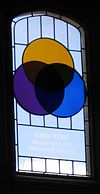John Venn
- See also John Venn (regicide). Another John Venn was Vice-Chancellor of Oxford University 1686–1687.
John Venn (born Hull, Yorkshire, August 4, 1834 – died Cambridge, April 4, 1923), was a British logician and philosopher, who is famous for conceiving the Venn diagrams, which are used in many fields, including set theory, probability, logic, statistics, and computer science.
John Venn's mother, Martha Sykes, came from Swanland near Hull, Yorkshire and died while John was still quite young. His father was the Rev Henry Venn who, at the time of John's birth, was the rector of the parish of Drypool near Hull. Henry Venn, himself a fellow of Queens', was from a family of distinction. His father, John's grandfather, was the Rev John Venn who had been the rector of Clapham in south London. He became the leader of the Clapham Sect, a group of evangelical Christians centred on his church who campaigned for the prison reform and the abolition of slavery and cruel sports.
Venn's father Henry also played a prominent role in the evangelical Christian movement. The Society for Missions in Africa and the East was founded by evangelical clergy of the Church of England in 1799 and in 1812 it was renamed the Church Missionary Society for Africa and the East. Venn's father was secretary to this Society from 1841. He moved to Highgate near London in order to carry out his duties. He held this position until his death in 1873.
As might be expected from his family background, John was strictly brought up, and there was never any thought other than that he would follow the family tradition into the priesthood. After Highgate School, Venn entered Caius College, Cambridge in 1853. He graduated in 1857 and shortly afterwards he was elected a fellow of the college. He was ordained as a deacon at Ely in 1858 and became a priest in 1859. In 1862 he returned to Cambridge as a lecturer in moral sciences.
Venn's main area of interest was logic and he published three texts on the subject. He wrote The Logic of Chance which introduced the frequency interpretation of probability in 1866, Symbolic Logic which introduced the Venn diagrams in 1881, and The Principles of Empirical Logic in 1889.
In 1883, Venn was elected to the Royal Society. In 1897, he wrote a history of his college, called The Biographical History of Gonville and Caius College, 1349–1897. A stained glass window in the college commemorates his work.
He commenced a complilation of biographical notes of the alumni of Cambridge University, a work which was continued by his son, John Archibald Venn (1883-1958) and published in 10 volumes from 1922-1953.
At Hull University, he is commemorated by the Venn Building, built in 1928.
In a recent BBC poll, Venn was voted as the third greatest mathematician of modern times, narrowly beaten by Sir Isaac Newton and Leonhard Euler, who ranked first and second respectively.
ReferencesISBN links support NWE through referral fees
John Venn (1880). On the Diagrammatic and Mechanical Representation of Propositions and Reasonings. Dublin Philosophical Magazine and Journal of Science 9 (59): 1—18.
Links
- The Venn archives clarify the confusing timeline of the various Venns.
- Fine portrait of Venn by Charles Brock, and a link to a site about Venn
- Another (clearer) view of the Venn stained glass window
| Persondata | |
|---|---|
| NAME | Venn, John |
| ALTERNATIVE NAMES | Венн, Джон (Russian) |
| SHORT DESCRIPTION | English logician |
| DATE OF BIRTH | August 4, 1834 |
| PLACE OF BIRTH | Hull, Yorkshire |
| DATE OF DEATH | April 4, 1923 |
| PLACE OF DEATH | Cambridge, England |
de:John Venn es:John Venn fr:John Venn gl:John Venn id:John Venn it:John Venn he:ג'ון ון mr:जॉन व्हेन nl:John Venn pt:John Venn ru:Венн, Джон
Credits
New World Encyclopedia writers and editors rewrote and completed the Wikipedia article in accordance with New World Encyclopedia standards. This article abides by terms of the Creative Commons CC-by-sa 3.0 License (CC-by-sa), which may be used and disseminated with proper attribution. Credit is due under the terms of this license that can reference both the New World Encyclopedia contributors and the selfless volunteer contributors of the Wikimedia Foundation. To cite this article click here for a list of acceptable citing formats.The history of earlier contributions by wikipedians is accessible to researchers here:
The history of this article since it was imported to New World Encyclopedia:
Note: Some restrictions may apply to use of individual images which are separately licensed.
